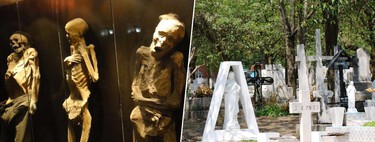All civilizations throughout history have had their customs and rituals. Many of these rituals involved drugs, and in terms of their nature, we have everything from the practice of looking into a volcano and throwing cows at it, to the Mayan ball games (also involving drugs), to the death industry of Egypt. And now… well, we tattoo the ashes of someone very close to us.
Returning to the Mayans, a decade ago a set of bones was discovered that were so well preserved that they are being exhibited in the Museum of Mayan Architecture of the Historic Center of Campeche under the name ‘The multiple burial of Uxul and the phenomenon of ritual violence’. The name leaves no room for doubt and hides a story as interesting as it is terrifying.
In perfect stateIn 2013, within the umbrella of the Uxul Archaeological Project, a collaboration between German and Mexican archaeologists from the INAH Campeche Center discovered the bone remains of some 20 individuals from the pre-Hispanic period. They were in excellent condition, which allowed the group to be documented and analyzed, since in addition to the bone remains, organic tissues were found that are rarely preserved.
These remains were buried in a cavity of gravel mass and sealed with a layer of mud. Animal bones and some tools were also found, but the special thing about all this is that the slab seemed to have not been disturbed since it was closed, so the remains had been protected from moisture, light and oxygen for centuries.
Every man for himself. From here, things get a little murky, and it must have taken investigators a while to do a body count. They found the remains of 14 men, one woman, several teenagers, a child of about 18 months, and a newborn. The problem is that virtually all of them were dismembered.
Archaeologists reported that the skeletons were not found in their natural anatomical articulation, as the arms and legs were separated from the torso, but also that almost all the skulls were scattered around the tomb. They had been decapitated, so to speak.


These marks show cut marks at the muscle intersections.


And with cruelty. Osteological analysis indicated that all the body parts found from the different bodies had identical cut marks and traumas in the same anatomical positions. This indicated to the archaeologists that these people had died in the same way (or so it was claimed) and in a single event.
But that is not all, as they also identified that most of these body parts had been exposed to an indirect heat source at around 200 degrees Celsius. Apparently, it was the ideal temperature to avoid calcination, but the reason is not known.
Systematic ritualsWhat does seem clear is that it was a ritual practice, an extreme violence that was practiced in these Uxul rites not against its own people, but against migrants. It is estimated that most of the individuals in that mass grave grew up in a region about 150 kilometers southeast of Uxul and that they had been brought to the area as captives. The reason may be a war between two peoples and these prisoners… well, they weren’t very lucky.
And the animals… Either way, these are people who died sometime in the 7th century AD and these conditions have allowed them, according to researchers, to be the best preserved Mayan remains in the world. And if you’re wondering what happened to the poor little animals buried, they were not dismembered or exposed to that heat source, but some do have marks that indicate they could have been used as food.
The truth is that the death must have been brutal (although in Europe we are not short with our torture machinery), but the good thing is that having buried them in that way has allowed the remains to reach our days in perfect condition and with a lot to tell in order to know a little more about the Mayans.
Images | INAH
In Xataka | This is how the Mayan cities of Yucatan were discovered in 1840: the story of the discovery that changed the history of Mexico











![[Img #74804]](https://thelatestnews.world/wp-content/uploads/2025/01/The-secrets-of-the-travels-of-migratory-bats-revealed-300x200.jpg)

Add Comment